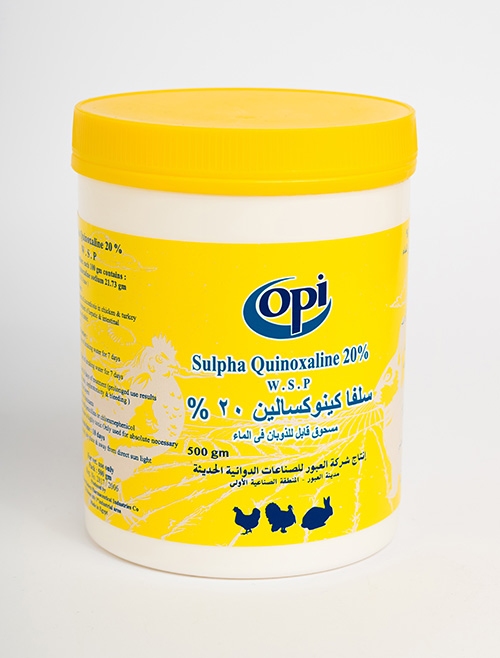Sulphaquinoxaline 20
dosage form : Water soluble powder
1-Composition:
Each 100 gm contains:
Sulphaquinoxaline Sodium 21.73 gm
( Sulphaquinoxaline 20 gm )
2-Properties:
Sulphaquinoxaline is one of The sulphonamides, antimicrobial and a coccidiostat for veterinary use
Sulphonamides form an extensive series of drugs that differ more in their physicochemical characteristics, and hence in mode of administration and pharmacokinetics,
than they do in their antibacterial activity .
They act by competing with tissue factors, notably p-aminobenzoic acid, and
are therefore inactive in the presence of necrotic tissue.
They are bacteriostatic to a range of Gram-positive and Gram-negative bacteria. They are active against aerobic Gram-positive cocci and some rods and many Gram-negative rods including Enterobacteriaceae. Leptospira and
Pseudomonas spp. are resistant. Sulphonamides are also
active against Chlamydophila, Toxoplasma, and coccidia
Indications
*Acute Fowl cholera – TURKEYS AND CHICKENS: As an aid in the treatment of acute fowl cholera caused by Pasteurella multocida susceptible to sulfamethazine, sulfamerazine and sulfaquinoxaline.. *Coccidiosis – TURKEYS: As an aid in the treatment of coccidiosis caused by Eimeria meleagrimitis and E. adenoeides susceptible to sulfamethazine, sulfamerazine, and sulfaquinoxaline.. *Coccidiosis – CHICKENS: As an aid in the treatment of coccidiosis caused by Eimeria tenella and E. necatrix susceptible to sulfamethazine, sulfamerazine, and sulfaquinoxaline.Target species
Chickens and turkeysDosage & adminstration
Orally via drinking waterActive ingredient (Base)
500 mg / kg of body weight Whole Product: 25 g Powder of product per liter of drinking water for 3 consecutive daysWarning & precuations
- Do not use this product for birds producing eggs or cows producing milk and should stop using 10 days before slaughter if the animal produces meat for human consumption.
- May cause crystalluria and renal failure.
- May cause petechial haemorrhages, agranulocytosis and haemolytic anaemia due to vitamin K defiency with prolonged use.
- Not to be used in horses.
- Not used with penicillins or chloramephenicol
Side Effects
- May cause toxic reactions unless the drug is evenly mixed in water at dosages indicated and used according to directions.
- Do not give to chickens, or turkeys within 10 days of slaughter for food.
- Do not medicate chickens or turkeys producing eggs for human consumption.
- Make fresh drinking water daily.
Withdrawal time
- Turkey and chicken: 10 days before slaughter.






